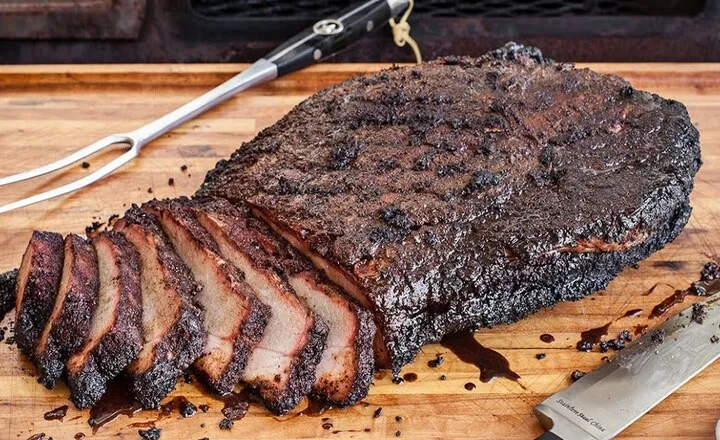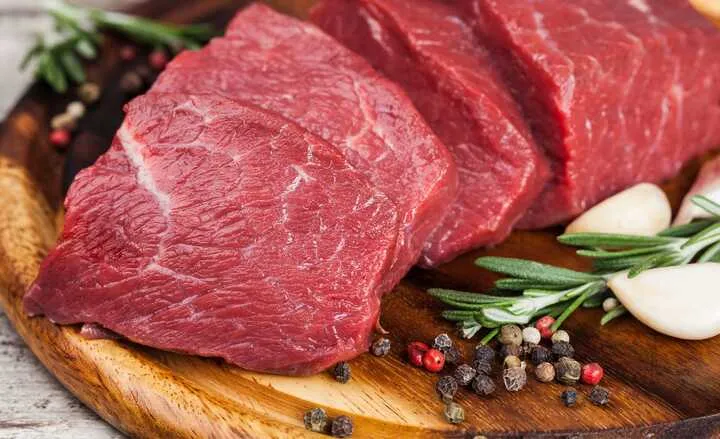Have you ever savored the rich, melt-in-your-mouth deliciousness of a perfectly cooked brisket? This culinary marvel has become a staple in barbecue joints and kitchens around the world. But have you ever wondered What Part of the Cow is Brisket? The answer may surprise you.
With its mouthwatering reputation, brisket is not sourced from some exotic region of the bovine anatomy – it’s actually one of the primal cuts nestled right below the first five ribs of the cow.
What Part of the Cow is Brisket?
Brisket is a cut of beef that comes from the chest muscles of cows or veal. Specifically, it is located right above the front legs of the animal, in the area between the front legs known as the breast, lower chest, or pectorals.
This cut includes both superficial and deep pectoral muscles and is taken from beneath the first five ribs before the foreshank. Brisket is known for its high-fat content and abundant connective tissue, which gives it a rich beefy flavor but also makes it tough.
Due to its well-exercised nature, brisket is best suited for low and slow cooking methods to break down the collagen and tenderize the meat.
When cooking brisket, it is important to give it enough time at a low temperature to ensure that it becomes tender and flavorful. Brisket can be quite large, weighing between 10 and 14 pounds, so it is often divided into two pieces and sold individually.
This cut is commonly used for roasts and skirt steaks but requires patience and skill to achieve optimal results in terms of tenderness and taste.
Cuts Of Brisket
There are three main cuts to choose from: the flat cut, the point cut, and the whole packer brisket. The flat cut is leaner and tends to be more uniform in shape, making it easier to slice for dishes like sandwiches or brisket tacos.
The point cut has more marbling and fat, which gives it a richer flavor but can be trickier to cook evenly. The whole packer brisket includes both the flat and point cuts, offering a variety of textures and flavors.
Deciding which cut of brisket to buy ultimately depends on your cooking method and recipe. If you’re smoking or slow-cooking the meat, a whole packer brisket may be the best choice for maximum flavor and tenderness.
For quicker cooking methods like grilling or braising, the flat cut or point cut could work well depending on your preferences for leaner or fattier meat. Experimenting with different cuts can help you discover your favorite way to enjoy this delicious beef dish.
Full Packer
It also known as Texas Brisket, is a favorite among many beef lovers for its rich flavor and juicy texture.
This cut combines both the Flat and Point portions of the brisket, separated by a layer of fat that adds to the overall succulence of the meat. Weighing anywhere from 8 to 20 pounds, this cut requires skill and expertise to ensure even cooking due to its uneven thickness.

Chefs who have mastered the art of cooking Full Packer brisket can create a mouthwatering dish where the thicker part is perfectly cooked while the thinner part remains moist and tender.
While some may argue that Full Packer brisket is not a distinct variety on its own, its unique composition and cooking requirements set it apart from other cuts of beef. The additional layer of fat covering the top can be trimmed to enhance the flavors and textures of this cut.
Flat Cut
Known as the first cut or deep pectoral, is a leaner portion of the brisket located towards the interior of the cow against the ribs. It is characterized by its thin, rectangular appearance and a thin layer of fat called the cap.
Keeping this layer of fat can help retain moisture and enhance flavor during cooking. While it’s up to personal preference whether to keep or trim the cap, leaving about 1/4 inch to 1 inch can be beneficial.
Due to its lean texture and uniformity, the flat cut is a popular choice for dishes like corned beef and pastrami. Its versatility allows for easy slicing and makes it a high-demand cut in many culinary applications.
Point
It is a flavorful and juicy cut of meat with a higher fat content compared to the Flat or First Cut. This triangular portion of the brisket contains more connective tissue and marbling, giving it a rich beefy flavor that is perfect for dishes like hamburgers and shredded barbecue beef sandwiches.
Due to its high-fat content, the Point is well-suited for smoking as it helps keep the meat moist and tender throughout the cooking process.
When cooking with the Point brisket, it is important to take into account its unique characteristics such as its irregular shape and high-fat content.
These qualities contribute to its succulent texture and intense beef flavor, making it a popular choice for BBQ enthusiasts looking to create mouthwatering smoked meats.
What Does Brisket Tastes Like?
Brisket is a cut of beef that is known for its rich, meaty flavor and tender texture. When cooked properly, brisket can be incredibly flavorful and satisfying. The taste of brisket can vary depending on the cooking method used.
When brined and smoked, brisket takes on a smoky and savory flavor profile, with a crispy exterior and juicy interior. Braised brisket tends to be more tender and stewed, with a less intense flavor compared to smoked brisket.

Brisket has a distinct beefiness that is enhanced by the cooking process. It is often described as chewy, robust, and savory when prepared correctly.
Trimming Fat From the Brisket
It’s important to strike a balance between removing excess fat and retaining enough to keep the meat juicy during cooking. A good rule of thumb is to leave about 1/4 inch of fat on the brisket, as this will help prevent the meat from drying out.
The layer of fat should be evenly distributed throughout the piece of meat, providing flavor and moisture as it cooks.
It’s also essential to recognize the difference between the Flat and Pointcut sections of the brisket when trimming fat. Each part may require slightly different trimming techniques to achieve optimal results.
By carefully managing the amount of fat left on the brisket, you can ensure a delicious and tender final product that is sure to impress your guests.
Cooking Beef Brisket
It can be a delightful culinary experience, as this tough cut of meat transforms into a tender and flavorful dish when prepared with care. Whether you’re making BBQ, corned beef, or pot roast, the key is to cook the brisket slowly at a low temperature to break down its connective fibers.
Smoking or braising are popular methods that allow the meat to become tender and juicy over time.

When preparing beef brisket, consider rubbing it with a flavorful spice blend before slow smoking it over a wood fire for that classic smoky flavor.
Braising the brisket for several hours allows it to absorb liquid from vegetables and break down collagen fibers, resulting in a melt-in-your-mouth texture.
Conclusion
The brisket is a flavorful and versatile cut of meat that comes from the chest area of the cow. While it may require a longer cooking time to achieve tenderness, the rich taste and juicy texture make it a popular choice for barbecue enthusiasts and chefs alike.
Understanding where the brisket comes from on the cow can help you appreciate this cut even more and inspire you to explore different cooking methods to bring out its full potential. Whether you prefer smoking, braising, or roasting, mastering the art of cooking brisket can elevate your culinary skills and impress your guests.
FAQs
How long to cook brisket?
Cooking brisket can take anywhere from 4-6 hours, depending on the size of the brisket and the cooking method used.
How many cuts of brisket per cow?
The number of cuts of brisket per cow can vary depending on the size and weight of the animal. A cow can yield around 2-3 cuts of brisket,
What part of the cow is wagyu?
Wagyu is a type of beef that comes from Japanese cattle breeds known for their exceptional marbling and tenderness.
